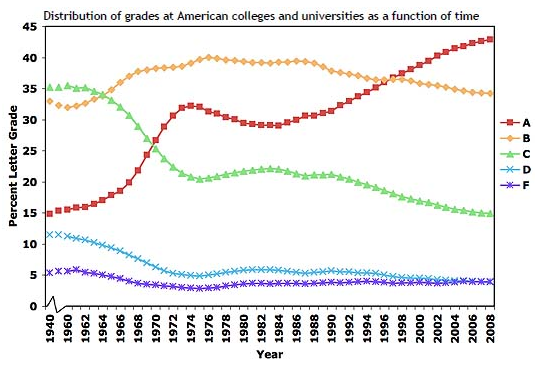…from U.S. researchers Stuart Rojstaczer and Christopher Healy on the subject of grade inflation. So fantastic, in fact, that I think I’ll mostly let them speak for themselves.
And this, of course, is at a time when institutions are becoming less selective, not more. Interestingly, though, it’s U.S. private universities – generally speaking more selective than publics – that are leading the grade inflation charge.
Since there’s no data to suggest that students are working harder than they used to, this is pretty much a straight-up change in grading practices. But what’s causing the change?
Canadian commentators James Coté and Anton Allahar would probably have you believe that grade inflation (or grade compression, as they more accurately dub it) is all due to the way that larger classrooms, disengaged students and manipulable teacher- evaluation schemes have given professors incentives to reduce standards – “they pretend to learn, we pretend to evaluate,” so to speak.
But this data – which shows that grade inflation/compression was more severe at the smaller and more selective institutions – suggests something different may be going on. In fact, Rojstaczer and Healy posit that the reverse is true – that diminished faculty disengagement expectations might be leading to disengagement.
Food for thought.



 Tweet this post
Tweet this post

hi Alex
check out our HEQCO paper below especially tables 4 and 5. at least at these 4 ontario universities there is no sign of peristent grade inflation. average GPA after 2 years did go up for the double cohort but that would be expected due to greater selectivity (the grade standards for admission rose too). average GPA’s fell back down after the double cohort passed through.t
http://www.heqco.ca/SiteCollectionDocuments/Persistence_in_University_ENG.doc
best wishes,
Martin